2021「西大墩老二媽省親幸福行腳」
景點A1
烈美堂
臺中市西屯區「烈美堂」為廖烈美祖居。廖烈美生於乾隆34年(1769),卒於道光24年(1844),享壽76歲。
嘉慶初,廖烈美自原籍福建省漳州府詔安縣二都官陂遷臺,定居於西大墩闢地墾荒。於該地挖掘七口魚池,供族人及當地農民取水灌溉。廖烈美在此創建大漁池祖居。昭和元年至2年(1926-27)重建。
祭祀公業廖烈美管理委員會於民國68年(1979)成立。烈美堂於民國75年(1986)起改建,民國77年(1988)安座落成。
「烈美堂」亦為市定古蹟南屯萬和宮老二媽(廖店媽)之祖居地。烈美堂門口原有的「大魚池」,於民國85年被政府徵收,闢作西平公園。清朝嘉慶年間(19世紀初),即有萬和宮「老二媽省親」的文化活動。至今仍維持每三年舉辦一次的傳統。
Lieh Mei Hall
Lieh Mei Hall is the ancestral residence of Liao, Lieh-mei in Xitun District, Taichung City. Liao, Lieh-mei was born in 1769 and died in 1844 at the age of 76.
At the beginning of Jia Qing, Liao moved to Taiwan from Zhang Zhou, Fujian Province, and he settled in the West Dadun to cultivate the land. Seven fish ponds were dug there for his clan and local farmers to get water for irrigation. Liao, Lieh-mei built the ancestral residence of Da-yu-chi here. It was rebuilt in 1926-27.
The management committee of Liao, Lieh-mei, a public worship service, was founded in 1979. Lieh Mei Hall was renovated in 1986, and the renovation was complete in 1988.
Lieh Mei Hall is also the ancestral residence of the Lao-erh-ma of Nantun Wan He Shrine, a city-designated historical site. The original " Da-yu-chi " at the entrance of Lie Mei Hall was expropriated by the government in 1985 and set aside as Xi Ping Park. During the Jia Qing period of the Qing Dynasty (early 19th century), a cultural event called " Wan He Shrine’s Lao-erh-ma’s visit to her relatives” was held. The event is held triennially.

▲烈美堂前大漁池意象造景(圖片來源:劉禪穎拍攝)

▲烈美堂正面照(圖片來源:劉禪穎拍攝)
2021「西大墩老二媽省親幸福行腳」
景點A2
老二媽神像
約於清朝嘉慶7年(1802),此為老二媽神轎上所刻之建造年,臺中市南屯區萬和宮為方便信徒迎請媽祖祭拜,增塑一尊二媽神像。當時一賣針線女紅的貨郎,自南屯至西屯沿途叫賣,遇一梳理整齊少女正在趕路。經詢問,得知少女名「廖品娘」,住西屯大漁池,有急事趕往萬和宮。少女求貨郎轉告家人,庭前桂花樹下藏銀元二枚,請家人取用勿念。經貨郎轉告後,家人察覺少女已往生。事後果真於桂花樹下挖出銀元。隨後其家人趕往萬和宮,又見二媽神像流淚,便深信「廖品娘」依靈於萬和宮所雕塑之第二尊媽祖神像。
Lao-erh-ma statue
In the year 1802, the year of the construction of the sedan chair, a statue of Lao-erh-ma was added to the Wan He Shrine in the Nantun district of Taichung to make it easier for worshippers to worship Lao-erh-ma. At that time, a needlework merchant was hawking along the road from Nantun to Xitun. He came across a girl looking neat and tidy, and she was in a hurry to go somewhere. He found out that she was named "Liao Pin Niang" and lived in Tai-yu-chi in Xitun, and that she was in a hurry to go to Wan He Shrine. The young girl asked the merchant to tell her family that there were two silver dollars hidden under the laurel tree in front of the yard and asked them not to miss her. After the merchant told her parents, the family realized that their girl had already passed away, and it was the spirit of Pin Niang that the merchant saw. Afterwards, they did dig up the silver dollars under the laurel tree. The family then rushed to the Wan He Shrine and saw the Lao-erh-ma statue’s face with tear, so they were convinced that the spirit of "Liao Pin Niang" stayed with Lao-erh-ma statue sculpted at the Wan He Shrine .
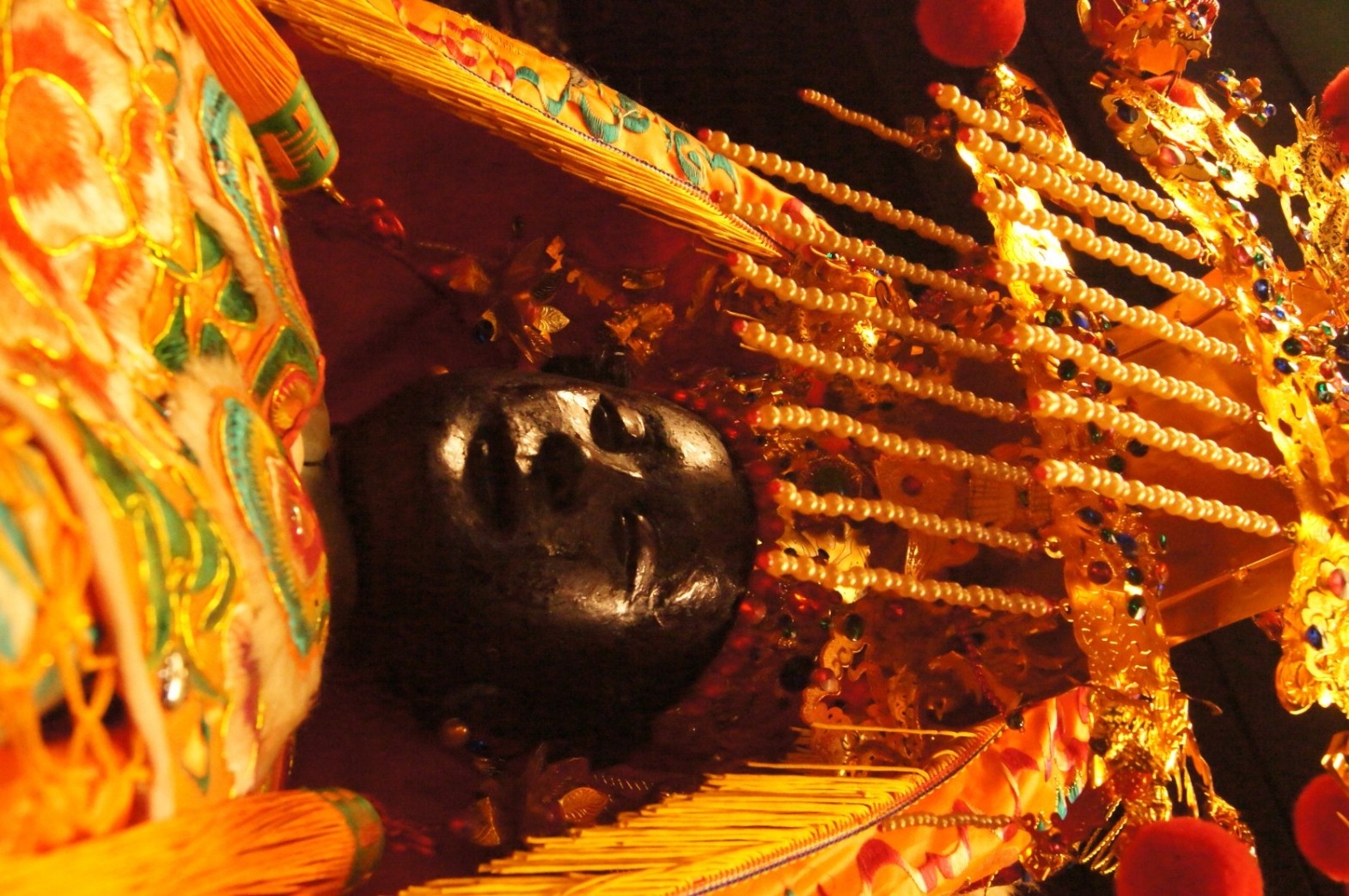
▲老二媽臉龐上的淚痕(圖片來源:陳瑛珣拍攝)
2021「西大墩老二媽省親幸福行腳」
景點A3
老二媽神轎
嘉慶7年(1802)製作的二媽轎輦,鎏金華麗。曾經在大正14年(1925)重修,根據廖財助的描述,當時修過4面雕花;目前老二媽轎輦時間既久,顧及安全,曾抽換新木板。
日治時期,由於二媽省親繞境行經路線,未能完全滿足廣大信徒期望,於是增塑分身一尊,增闢繞境路線。為了與原來的二媽區分,稱原來的二媽為「老二媽」,新塑的二媽分身稱「聖二媽」。
聖二媽轎於大正13年(1924)製作,圖面墨色繪圖案,相當文雅,可惜未記錄匠師姓名。轎輦正面右上方刻著:「大正拾叁年甲子冬月穀旦」。正面為神明會:「慶和季、復興季」,左上方記錄地點為「西屯莊」,並記錄建造者為:「廖田成、廖恩旺、廖正坤」。時地人事記錄齊全,屬於具有史料價值的文物。
Lao-erh-ma sedan chair
This is a gorgeous sedan chair made in 1802. It was rebuilt in 1925, and according to Liao's description, four sides were rebuilt at that time.
Lao-erh-ma sedan chair, made in 1802, is so gorgeous. According to Liao's description, it was restored in 1925 and four side of carvings were repaired. For safety, the boards were replaced with new ones.
During the Japanese ruling, because the route of “Lao-erh-ma’s visit to her relatives” did not meet the expectations of believers, an additional doppelganger statue was sculpted for an additional detour route. In order to distinguish the doppelganger statue from the original Lao-erh-ma statue, therefore, the original statue was called " Lao-erh-ma " and the newer doppelganger statue was called " Sheng-erh-Ma ."
The Sheng-erh-ma sedan chair was made in 1924 and is elegantly painted in ink, but the name of the craftsman is not engraved on it. The upper right side of the front of the sedan chair reads as follows : "Taisho Jizhi, the winter month of the 13th year, Gudan". " Shen Ming Huei (Gods’ Association)": "Qing He season, Fu Sing season" was engraved on the front side, and the location of "Xitun zhuang" and the name of builders "Liao, tian-cheng, Liao, en-wang, Liao, zheng-kun"was engraved on the upper left. It is a complete record of the time and place, and it is a relic with historical value.
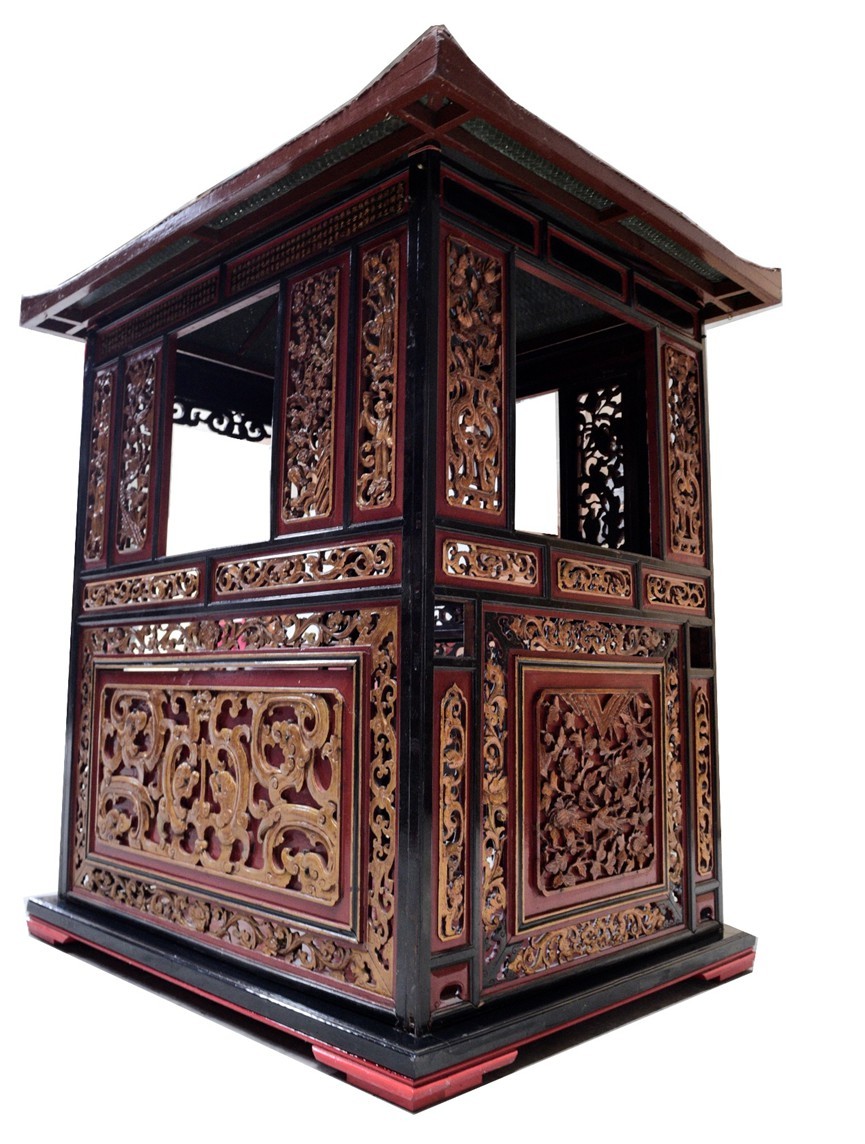
▲老二媽神轎(圖片來源:陳瑛珣拍攝)
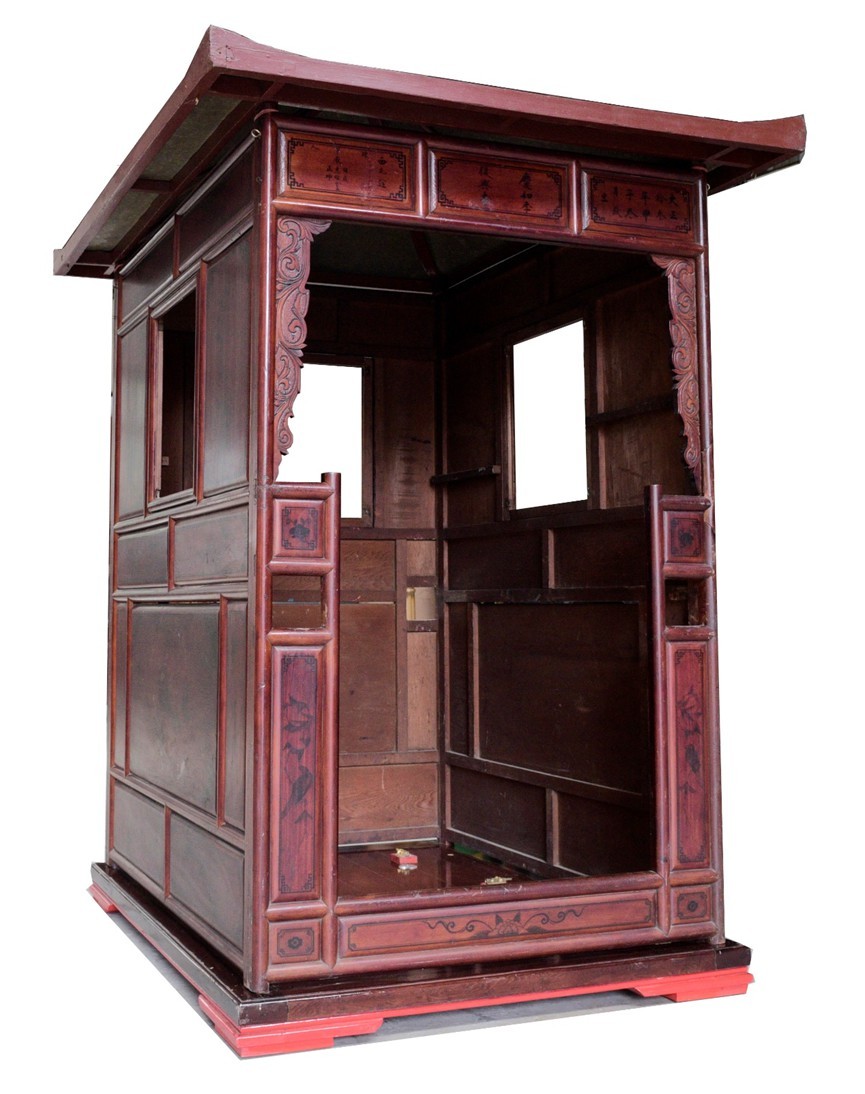
▲聖二媽神轎(圖片來源:陳瑛珣拍攝)
2021「西大墩老二媽省親幸福行腳」
景點A4
隆興宮王爺廟柱子上的頂尖書法家劉曉邨墨寶
隆興宮王爺廟主祀「朱、李、池」三府王爺,高懸的「大顯靈威」古匾,上書「咸豐九年(1859)」,歷史悠久。
殿前立有石柱兩對,前置石柱上寫著「昭和貳年(1927)丁卯孟秋立」,後置石柱上寫著「昭和貳年(1927)丁卯季夏立」。可見石柱打造時間同年不同月。兩對石柱書寫人並不相同
前置一對石柱的題字,出自開發臺中石岡土牛的劉元龍宗族頂尖書法家劉曉邨手筆。劉曉邨是被日本評定為「正七段」的頂尖書法家。他的墨寶彌足珍貴。
The calligraphy of Liu, Xiao-Chun on the pillars of the Long Xing Shrine (Wang Ye Temple)
Long Xing Gong Wong Yeh Shrine, dedicated to the three royal lords of Zhu, Li and Chi. "Da Xian Ling Wei" and "Xian Feng
In front of the temple are two pairs of stone pillars. The front pillars read as follows: " in autumn, the second year of Shōwa Era (1927)." The rear pillars read as follows: " in summer, the second year of Shōwa Era (1927)". It can be seen that the pillars were built in the same year but in different months. The stone pillars were written by different people.
The inscription on the front stone pillar was written by Liu Xiao-Chuan, the top calligrapher of the Liu Yuan-Long clan that developed the land of Tu-Niou in Shi-Gang, Taichung. A special, unprecedented title was bestowed on him by the Japanese. His calligraphy is very precious.

▲隆興宮王爺廟柱子上的頂尖書法家劉曉邨墨寶(圖片來源:劉禪穎拍攝))

▲隆興宮王爺廟柱子上的頂尖書法家劉曉邨墨寶(圖片來源:劉禪穎拍攝))

隆興宮王爺廟正面照(圖片來源:劉禪穎拍攝)
2021「西大墩老二媽省親幸福行腳」
景點A5
西墩福德祠
進入西屯菜市場後不久,就可見到香火鼎盛的西墩福德祠。福德祠年代久遠,可以追溯到清朝乾隆中期,張廖宗族拓墾西大墩的年代。日治大正10年(1921),移民拓墾有成,購地建屋,坐擁田園、宅第,族親欣慰之餘,感念土地公的保佑,就在當地仕紳倡議下,正式為福德正神建廟。民國70年(1981)重建後為今日樣貌。
福德祠供奉土地公、土地婆。位於拜庭左前方馬路上,有一棵老榕樹,依民間信仰風俗設置神龕、香爐供信眾膜拜。
Xidun Fude Ancestral Hall
Soon after entering the Xitun Market, you will be able to see the Xidun Fude Hall which is bustling with pilgrms/worshippers. It dates back to the middle of the Qian Long period of the Qing Dynasty when the Zhang Liao clan cultivated the land of Xidun. In the 10th year of the Taisho era (1921), the immigrants were able to buy land to build houses. The initiative, presented by local gentry, to build Fude Hall for the blessing of the God of the Land was well-accepted by the clan. In 1981, the temple was renovated to the way it looks like.
Fude Hall is dedicated to the God of land and the Goddess of land. There is an old banyan tree located in front of the road to the left of the temple, with a shrine and incense burner for the worship of the faithful according to folk customs.

▲西墩福德祠正面照(圖片來源:劉禪穎拍攝)

▲西墩福德祠與大榕樹(圖片來源:劉禪穎拍攝)
2021「西大墩老二媽省親幸福行腳」
景點B1
清靈宮
清靈宮建於清咸豐11年(1861),占地大約100多坪,是西屯老街三座廟宇中面積最大的。原址在光明路171號,昭和2年(1927)在一場火災中,全部燒毀。清靈宮現址,原為丹慶季媽祖會派下土地。昭和7年(1932)由丹慶季媽祖會提供土地,遷建至現址。民國60年成立「財團法人清隆福宮」。民國77、90、95年曾多次重修。103年財團法人清隆福宮取得部份土地的持分。
清靈宮主祀三官大帝,配祀天上聖母(媽祖)。三官是天、地、水三官的簡稱。傳說天官是紫微大帝,地官是清虛大帝,水官洞陰大帝。又有一說,天官是指堯、地官是指舜、水官是指禹,顯然由自然崇拜,轉化成對聖賢崇拜。
西屯地區早期並未有媽祖廟,清靈宮最早的媽祖神像在民國16年不幸在火災中燒毀。重建廟時重新塑一尊,採用竹編再以紙糊而成。據廟公表示:由於竹編易蛀,前幾年已化掉再重塑。
Qing Ling Temple
Qing Ling Temple was built in 1861, covering an area of about 330,58 square meters, is the largest of the three temples on Xitun Old Street. It was originally located at 171 Guang Ming Road, but it was completely destroyed in a fire in 1927. The present site of the Qing Ling Temple was originally the land of the Dan Qing Ji. In 1932, the land was provided by the Dan Qing Ji (Mazu Association)and the temple has been moved to the current site.
In 1971, "Ching Lung Fu Temple" was built. It was restored several times in the years of 1988, 2001, and 2006. In 2014, Qing Long Fu Temple Foundation acquired a portion of the landholdings.
Qing Ling Temple is dedicated to the San Guan Emperor and the Heavenly Mother(Mazu). San Guan is the abbreviation for the three gods of Heaven, Earth and Water. For the worship of nature, it is said that Heavenly God is the Zi Wei Emperor, and Earth God is the Great Qing Xu. Water God is the Great Tung Yin. For the worship of sages, legend has it that Yao is referred to as Heavenly God, and Shun is referred to Earth God, and Yu is referred to Water God. Obviously, there was a shift from the worship of nature to the worship of sages.
There was no Mazu temple in the early days of the Xitun area, and the earliest Mazu statue at Qing Ling Temple was unfortunately destroyed in a fire in the year of 1927. When the temple was rebuilt, a new Mazu statue was made of bamboo and paper mache. According to the temple host, the bamboo-weaved Mazu was easy to be damaged by worms. Therefore, it has been melted and remodeled a couple of years ago.

▲清靈宮(圖片來源:劉禪穎拍攝)

▲清靈宮(圖片來源:劉禪穎拍攝)
2021「西大墩老二媽省親幸福行腳」
景點B2
張廖家廟
張廖家廟為市定古蹟,亦稱張廖公廳、廖祖厝或天與公祠。由於用「承祜」作為堂號,故亦稱承祜堂。
該家廟座落處舊名西大墩街(今西屯一帶)。為原籍福建漳州府詔安縣二都官坡社藍田樓的張廖宗族所建。
此張廖家廟於光緒12年(西元1886年)倡議興建,獲得族人響應,至日治時期明治42年(1909)開始動工,大正5年(1916)完成所有建築。
張廖家廟是由三川殿、左右護龍及二個山門連接形成一格局頗為壯闊的長形立面。
由空中鳥瞰,可發現三川殿透過二條過水廊連上拜殿、正殿,形成封閉空間。此空間於祭祀儀典時,正可顯現其神聖性。
精緻的木結構的彩繪、屋樑上具有鎮邪和穩定大樑作用而造型奇特的獅座,以及藍漆圓窗配以灰色條紋的萬字圖案,其協調而樸拙的建築藝術風格,表露無遺。
Chang Liao Family Temple
The temple is also known as Chang Liao Kung Hall, Liao's ancestral residence, or Tian He Gong Ancestral Hall. It is also known as Cheng Hu Temple.
The temple is located in the area formerly known as Xi Da Dun Street ( Xitun). It was built by the Zhang Liao clan, originally from Lan Tian Lou, Guan Po She, Erh Du, Zhao An County, Zhang Zhou Province, Fujian.
The construction of this temple was initiated in 1886 with the support of the clan. The construction of this temple began in 1909 and completed in 1916.
The impressive, rectangular layout includes a San Chuan Hall, side wings, and two gates.
From an aerial view, one can see that the San-chuan Hall is connected to the worship hall and the main hall through two water crossings, forming an enclosed space. This space is a sacred space for rituals.
The exquisite woodwork, the strange lion base on the roof beam that serves to remove the evil spirit and stabilize the beam, and the round blue-painted windows with gray striped wan-letter pattern reveal the harmonious and simple architectural art style.
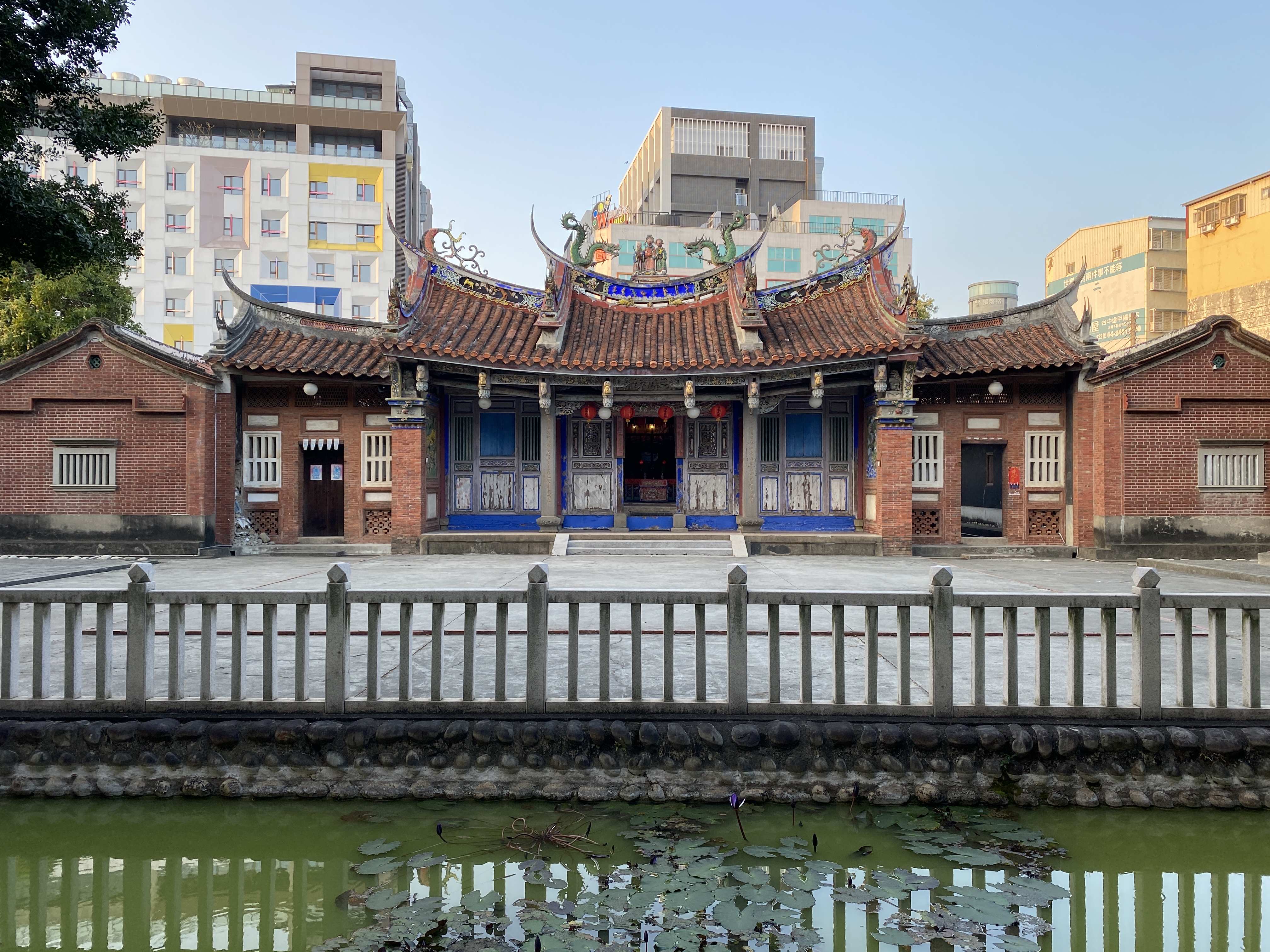
▲張廖家廟外觀(圖片來源:劉禪穎拍攝)

▲張廖家廟正面照(圖片來源:劉禪穎拍攝)
2021「西大墩老二媽省親幸福行腳」
景點B3
臺中國家歌劇院
繼臺北兩廳院後的另一個國家級歌劇院──臺中歌劇院,於2014年11月23日落成。2015年1月1日閉館施作第二、三期工程,並在2016年9月30日正式開幕。
臺中歌劇院由獲得2013年普立茲克獎的日本建築大師伊東豊雄設計。在設計理念上,以人類最原始的「樹屋」、「洞窟」的概念,設計出「美聲涵洞」,被國際媒體贊譽為「世界第九大新地標」之一。
歌劇院三大特別的建築工法是:(1)「曲牆建築工法」(2)地下空調和椅墊下空調(3)「水幕消防設計」。前兩項建築工法獲得世界專利認證。
建築內部的牆面均為曲面,共58面曲牆,施作難度極高,被稱為「全球最難蓋的房子」,建築費用花費43.6億元。
對整個歌劇院深度了解之後,即令人敬佩伊東豊雄大師的精心設計,也為臺中市民能擁有身心靈最受歡迎的場所感到驕傲,進而成為城市記憶的一部分。
National Taichung Theater
National Taichung Theater, the next national opera house after the National Performing Arts Center - National Theater & Concert Hall, was built on November 23, 2014. It was closed on January 1, 2015 for the second and third phases of construction, and it was officially opened on September 30, 2016.
National Taichung Theater was designed by Toyo Ito, a Japanese architect who won the 2013 Pritzker Prize. In terms of the design, the "Sound Cave" was designed based on the concept of "tree house" and "cave", the most primitive of human beings, and it receives international praise as the 9th worldwide landmark in the world..
The three special construction methods of the Opera House are: (1) "curved wall construction method" (2) underground air conditioning and under-chair air conditioning (3) "water curtain fire protection design". An international patent of the first two construction methods is registered.
The interior walls of the building are curved, with a total of 58 curved walls, is extremely difficult to build. It is so called “the toughest building in the world.”
After having a better understanding of the entire opera house, one would admire the elaborate design of Master Toyo Ito and be proud that the resident of Taichung own the most popular venue for the mind, body and soul. National Taichung Theater has become a part of the city memory.
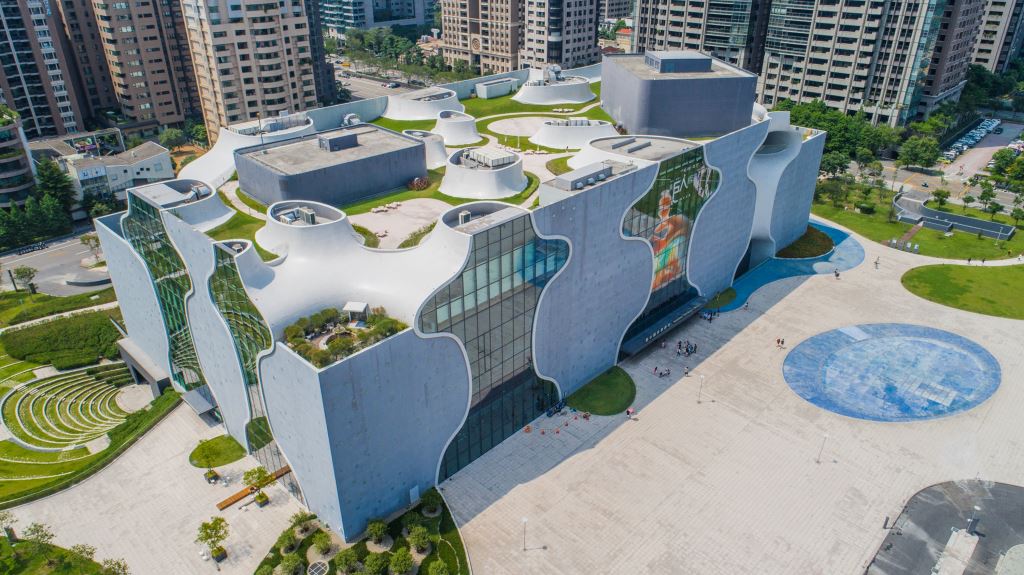
▲臺中國家歌劇院空拍圖(圖片來源:臺中觀光旅遊網)
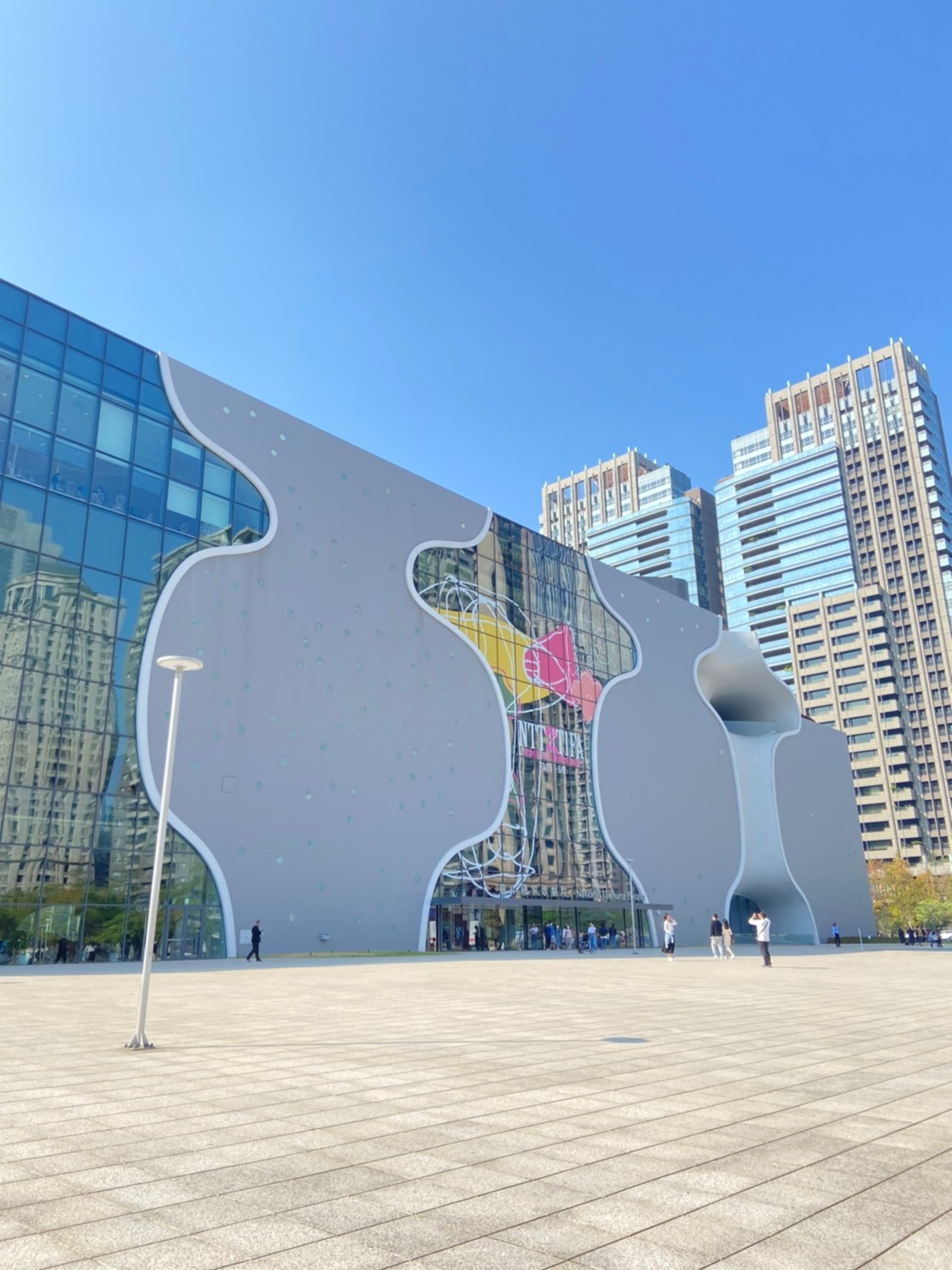
▲臺中國家歌劇院外觀(圖片來源:林奕萱拍攝)
2021「西大墩老二媽省親幸福行腳」
景點B4
秋紅谷
來到臺灣大道二段與朝富路口,就能看到被稱之為「都市之肺」的秋紅谷公園。投身於秋紅谷的懷抱,彷佛瞬間從車來人往的繁華都市,進入一個寧靜悠閒的都市森林中,倍感清新宜人。臺中市政府邀請設計國美館增建工程的楊家凱建築師規劃,依據現有被挖空的地型,以濕地景觀為設計基礎,建造一顆掉落人間的綠寶石在七期重劃區中。
由於位於地價昂貴的區段,周遭高樓林立,所以成了身價最高的滯洪池公園。秋紅谷公園所有的設計與考量都是以人本、綠能與滯洪為最大考量,不僅種植植物所需的灌溉水是以湖水供應,連回填所需用的土壤也是與水利署協調利用大里溪疏濬的土壤,成為全臺首座「下凹式」的生態公園)
秋紅谷公園的設立,是希望讓市民的生活更感輕鬆、從容,同時兼具景觀、生態、滯洪、排水與調節空氣品質……等等的功能。
占地3公頃多的秋紅谷公園,白天有舒服的綠意;夜晚有著精采多變的不夜燈火。有湖泊、紅樹、綠草坪、觀景橋,相當適合散步、約會、運動。
Maple garden
At Chaofu-Taiwan Boulevard intersection, you will see Maple Garden, the lung of the city. When you are in the embrace of Maple garden, you will feel like you are moving from the bustling city to a quiet and relaxing urban forest, which is very refreshing. The Taichung City Government invited architect Yang, Jia-Kai, who designed the addition work to the National Museum of Fine Arts, to create a green gem in the seventh phase of the land consolidation, based on the U-shaped and the wetland landscape.
Since it is located in an expensive area and surrounded by many high-rise buildings, it has become the most expensive park with flood carrying capacity in the area. The design of Maple Garden is based on humanism, green energy and flood carrying capacity. For water resource, the water supply for the plants is the lake. Maple Garden and Water Resources Agency, Ministry of Economic Affairs coordinate their efforts to use the dredged soil from Da Li River for backfilling. It is the first U-shaped ecological park in Taiwan.
Maple Garden, with the functions of landscape, ecology, flood retention, drainage, and air quality regulation, was established in hopes of making people's lives easier and more relaxing.
Maple Garden has an area of 3 hectares, and it contains a lake, red trees, green grass, and observatory bridge. It is a great place for talking a walk, going on a date, and exercising. During the day, there is comforting greenness, and at night, it is filled with sleepless lighting.

秋紅谷西側(圖片來源:劉禪穎拍攝)

▲秋紅谷東側(圖片來源:劉禪穎拍攝)
2021「西大墩老二媽省親幸福行腳」
景點B5
文心森林公園
文心森林公園佔地8.86公頃,位於文心路與向上路交界處,入口處可看見類似雪梨歌劇院白色圓頂建築。圓滿戶外劇場舞臺頂蓋的造型構想,源於中國傳統舞蹈『彩帶舞』的彩帶舞動韻律意象,希望將彩帶般輕盈、驚豔卻又簡潔之造型量體,漂浮於專為遊客們打造的親切、專業的表演場地上。化妝室亦是一處特色,圓弧型的建物,除美觀外,彷彿在與圓滿劇場相呼應。可容納將近六千人的圓滿戶外劇場,是公園內的地標,很多活動和藝文音樂演唱會選擇在此舉行。
園區整體配置採用「以蒼穹為幕、綠草為蓆」的構想,主要配置有五大項目:以自然為主軸的園區配置、與大地共舞的戲劇音樂森林、多層次景觀與生態環境規劃、環繞串聯全區的遊園步道系統、以地景手法圍塑圓滿戶外劇場,創造自然管制屏障。希望遊客們倘佯在園區的悅目景物中,猶如悠遊於藍天碧草之間。
Wen Xin Forest Park
Located at the intersection of Wen Xin Road and Xiang Shang Road, the 8.86-hectare Wen Xin Forest Park has a white dome similar to the Sydney Opera House at the entrance. The shape of the roof of the outdoor theater is inspired by the rhythm of the ribbons in the traditional Chinese dance "Ribbon Dance" to bring the light, stunning and simple shape of ribbons to float in a professional performance stage for visitors. The dressing room, also a special feature with a circular building, really complements the theater. The outdoor theater, with a capacity of nearly 6,000 people, is a landmark in the park and is the venue for holding many events and concerts.
The overall configuration of the park is based on the concept of "the dome as a curtain and the green grass as a mat." There are five major items in the configuration: the main configuration of the park with nature, the theatrical and musical forest that dances with the earth, the multi-level landscape and ecological environment, the park trail system that circles and links the whole area, and the ground scenery that surrounds the Fulfillment Amphitheatre to create a natural barrier. We hope that visitors will enjoy the beautiful scenery of the park as if they were wandering in the blue sky and blue grass.
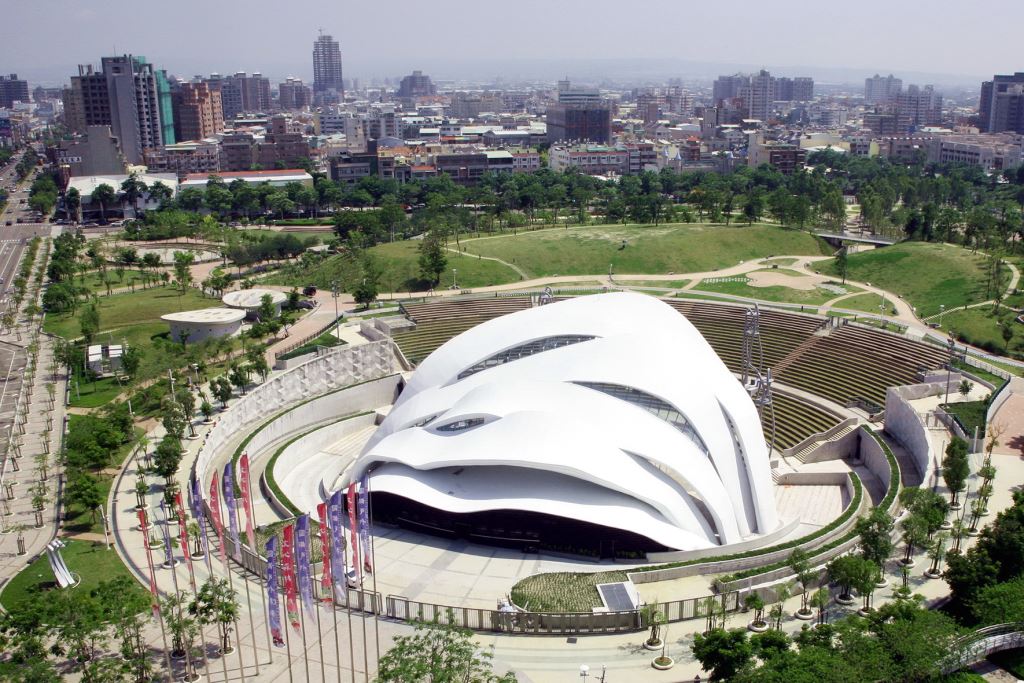
▲文心森林公園空拍圖(圖片來源:臺中市圓滿戶外劇場全球資訊網)

▲文心森林公園內部(圖片來源:劉禪穎拍攝)
資料來源:陳瑛珣提供
